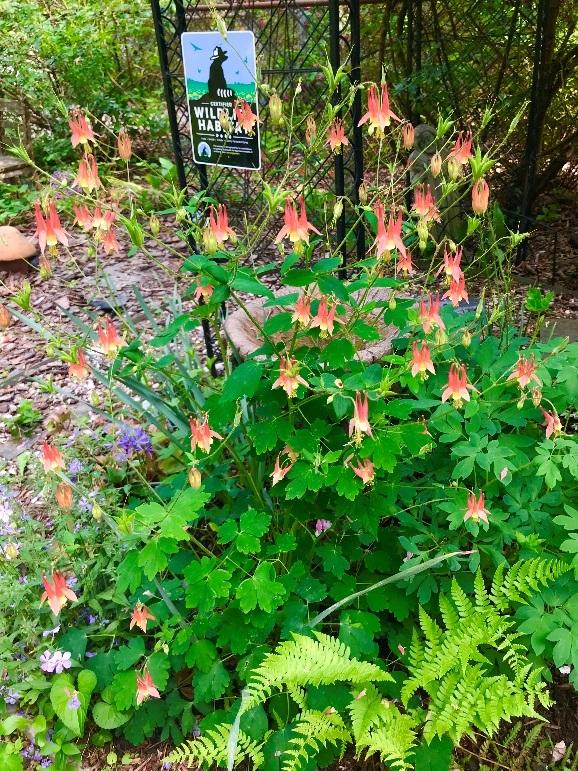Photo Credit Michael McGinnity- NWF Photo Contest
Each year as we rediscover the emerging beauty of our gardens, we can also welcome and enjoy birds, butterflies, pollinators and other wildlife. Garden for Wildlife Month in May andNational Pollinator Week, June 18-24, 2018 remind us to prepare our gardens as a habitat for wildlife. Here are starter tips for wild friendly gardening. Visit nwf.org/garden for more ways to provide food, water, cover and places for wildlife to raise their young.
1. Provide a Water Source for Wildlife to Bathe and Drink.
 Not only does a water source provide sound and movement in your garden, it provides an essential habitat element for wildlife to survive. Birds need to bathe in order to keep their feathers in good working order, other species, such as some amphibians actually live in water. All wildlife needs to drink water.
Not only does a water source provide sound and movement in your garden, it provides an essential habitat element for wildlife to survive. Birds need to bathe in order to keep their feathers in good working order, other species, such as some amphibians actually live in water. All wildlife needs to drink water.
In urban and suburban areas consider adding bird baths or container water gardens with bubblers to keep water moving and deter mosquitoes. For larger areas, consider adding a rain garden, or small pond.
2. Discover Native Plants with a Visit to a Native Plant Sale
Native plants are those that have co evolved with local wildlife and benefit the local food chain. Specific plants have been designed by nature to support specific animals. For example, milkweed is the only plant monarch butterfly caterpillars can feed on. And an oak tree supports up to 557 specific species of butterflies and moths, providing an abundance of food for the birds who feed on them.
Native plant societies, nature centers, and public gardens are hosting many plant sales this spring. Before you shop, check out NWF's Native Plant Finder, (www.nwf.org/nativeplantfinder) to down load a list by zip code for plants that support wildlife where you live.
3. Remove Invasive Plants
Invasive plants are often those that have been introduced to a region or country they do not naturally occur. In many cases, they crowd out important native plants and disrupt the natural ecosystem. Check out which species are considered invasive in your region.
Many county or state parks have teams of "weed warrior' volunteers which you can join to help remove invasive species. When you clear space for native plants to grow, you restore important species that wildlife depend on for their survival.
Incorporating these efforts into your garden routine will help qualify you to certify your garden and join more than 7 million people participating across the country in National Wildlife Federation's Garden for Wildlife movement, the nation's longest-running and largest effort dedicated to helping wildlife locally.
The initiative, celebrating 45 years, reconnects our neighborhoods, towns, and cities back to the country's amazing wild spaces. Garden for Wildlife encourages Americans to plant native plants - from wildflowers to trees - and to provide natural sources of food, water, cover, and places to raise young for wildlife in their backyards and communities.
National Wildlife Federation, along with the National Garden Association are co founders of the National Pollinator Garden Network that is trying to reach one million bee-friendly gardens in 2018.
Each Certified Wildlife Habitat is counted toward the Million Pollinator Garden Challenge map, and is helping revitalize the health of bees, butterflies, birds, bats and other pollinators across the U.S.
How Your Efforts Help Wildlife
 Every habitat garden is a step toward replenishing sources for wildlife such as bees, butterflies, birds and amphibians. By adding pollinator friendly and monarch friendly plants when you create and certify with the National Wildlife Federation, your garden also counts toward the Million Pollinator Garden Challenge. (add url). Certifications support National Wildlife Federation programs to inspire others to make a difference in addressing declining habitat for wildlife nationwide.
Every habitat garden is a step toward replenishing sources for wildlife such as bees, butterflies, birds and amphibians. By adding pollinator friendly and monarch friendly plants when you create and certify with the National Wildlife Federation, your garden also counts toward the Million Pollinator Garden Challenge. (add url). Certifications support National Wildlife Federation programs to inspire others to make a difference in addressing declining habitat for wildlife nationwide.
Certify now with our new mobile friendly online application at https://www.nwf.org/gardenNGA
SIGN UP TO LEARN MORE- BE ENTERED IN GARDEN FOR WILDLIFE GIVEAWAY
Sign up for the newsletter and enter to win here (link to this url) https://online.nwf.org/site/SPageNavigator/Subscribe_GardenForWildlife_eNewsletter2.html?2018NGA
| Thread Title | Last Reply | Replies |
|---|---|---|
| Manicured does not encourage wild life by CarolineScott | Jul 5, 2018 2:54 PM | 6 |
| Wild life by Tkhan | Jul 1, 2018 8:12 PM | 0 |